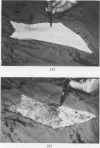Abstract
The author's experience of fourteen patients with necrotizing fasciitis is reviewed. The pathognomonic feature of this condition is an extensive necrosis of subcutaneous tissue caused by a vicious cycle of infection, local ischaemia and reduced host defence mechanisms. The diagnosis can only be confirmed by immediate exploratory incision. The reported mortality of 30-40% reflects the inadaquacy of conservative surgery in the treatment of this serious condition. Mortality can be reduced by early recognition followed by radical excision of the necrotic fascia and overlying skin. The preservation and subsequent use of the excised skin has the advantage of economy in the use of donor areas and reduction in morbidity. Hyperbaric oxygen therapy does not halt the spread of the necrotizing process and is not a substitute for radical surgery.
Full text
PDF





Images in this article
Selected References
These references are in PubMed. This may not be the complete list of references from this article.
- ABELE D. C., DOBSON R. L., NEWSOME J. F., LINEBERGER A. S. Progressive fatal cutaneous gangrene associated with hypogammaglobulinemia. Arch Dermatol. 1960 Oct;82:565–569. doi: 10.1001/archderm.1960.01580040083014. [DOI] [PubMed] [Google Scholar]
- Buchanan C. S. Necrotizing fasciitis due to group A beta-hemolytic streptococci. Arch Dermatol. 1970 Jun;101(6):664–668. [PubMed] [Google Scholar]
- Fedden W. F. Six Cases of Acute Infective Gangrene of the Extremities. Proc R Soc Med. 1909;2(CLIN):213–218. doi: 10.1177/003591570900200178. [DOI] [PMC free article] [PubMed] [Google Scholar]
- Grainger R. W., MacKenzie D. A., MaLachlin A. D. Progressive bacterial synergistic gangrene: chronic undermining ulcer of Meleney. Can J Surg. 1967 Oct;10(4):439–444. [PubMed] [Google Scholar]
- Ledingham I. M. Septic shock. Br J Surg. 1975 Oct;62(10):777–780. doi: 10.1002/bjs.1800621008. [DOI] [PubMed] [Google Scholar]
- Ledingham I. M., Tehrani M. A. Diagnosis, clinical course and treatment of acute dermal gangrene. Br J Surg. 1975 May;62(5):364–372. doi: 10.1002/bjs.1800620510. [DOI] [PubMed] [Google Scholar]
- Meade J. W., Mueller C. B. Necrotizing infections of subcutaneous tissue and fascia. Ann Surg. 1968 Aug;168(2):274–280. doi: 10.1097/00000658-196808000-00014. [DOI] [PMC free article] [PubMed] [Google Scholar]
- Rea W. J., Wyrick W. J., Jr Necrotizing fasciitis. Ann Surg. 1970 Dec;172(6):957–964. doi: 10.1097/00000658-197012000-00005. [DOI] [PMC free article] [PubMed] [Google Scholar]
- Roberts D. B., Hester L. L., Jr Progressive synergistic bacterial gangrene arising from abscesses of the vulva and Bartholin's gland duct. Am J Obstet Gynecol. 1972 Oct 1;114(3):285–291. doi: 10.1016/0002-9378(72)90605-9. [DOI] [PubMed] [Google Scholar]
- Tehrani M. A., Webster M. H., Robinson D. W., Ledingham I. M. Necrotising fasciitis treated by radical excision of the overlying skin. Br J Plast Surg. 1976 Jan;29(1):74–77. doi: 10.1016/0007-1226(76)90097-7. [DOI] [PubMed] [Google Scholar]
- WILSON B. Necrotizing fasciitis. Am Surg. 1952 Apr;18(4):416–431. [PubMed] [Google Scholar]
- Webb R., Berg E. Symbiotic gangrene due to Pseudomonas pyocyanea and E. coli. Aust N Z J Surg. 1966 Nov;36(2):159–160. doi: 10.1111/j.1445-2197.1966.tb05510.x. [DOI] [PubMed] [Google Scholar]
- Wilson H. D., Haltalin K. C. Acute necrotizing fasciitis in childhood. Report of 11 cases. Am J Dis Child. 1973 Apr;125(4):591–595. doi: 10.1001/archpedi.1973.04160040087018. [DOI] [PubMed] [Google Scholar]




